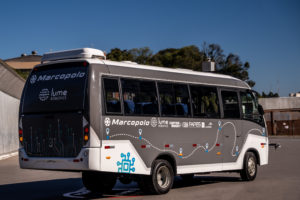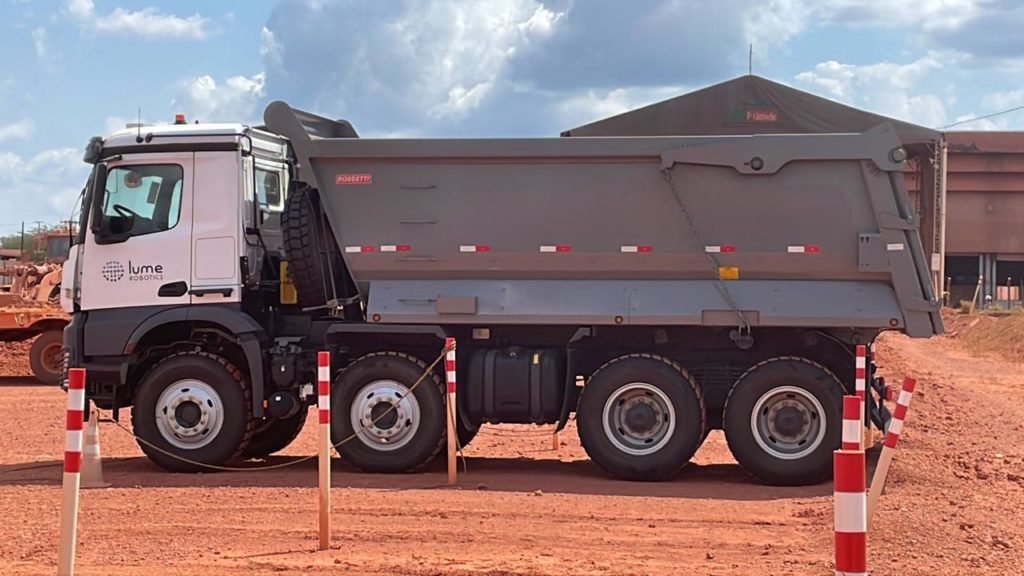Autonomy in mining fleets is not restricted to the large truck OEM-led systems from Caterpillar, Komatsu, Hitachi and others. ASI Mining, recently fully acquired by Epiroc, has been on its own OEM-agnostic AHS journey at Roy Hill for some years now, while a raft of other technology providers have also been very active, including Pronto, SafeAI, Steer and xtonomy. Chinese players TAGE Idriver and Waytous have an important position in the Chinese market, while China’s Eacon Mining is building on its strength in China and is building a position in Australia and further afield, having signed agreements both with MACA and its parent Thiess.
In Brazil, contractor U&M Mineração e Construção S/A rolled out its own AHS at a mine on Caterpillar 777 trucks last year. But a second company in Brazil is also making a name for itself in autonomous driving in mining is Lume Robotics, based in Vitoria. Lume Robotics is a startup founded in 2019 by researchers participating in the IARA Project (Intelligent Autonomous Robotic Automobile) at the High-Performance Computing Laboratory (LCAD) at the Federal University of Espírito Santo (UFES), started in 2009. With expertise in advanced technologies, such as deep neural networks (Deep Learning), Artificial Intelligence, computer vision and autonomous robotics, Lume Robotics says it directs its knowledge “to develop solutions that solve practical problems in industry and society, putting people first.”
Lume Robotics CEO, Ranik Guidolini

IM Editorial Director Paul Moore recently caught up with Lume Robotics CEO, Ranik Guidolini. He explained that the Lume system uses data collected by external (LiDAR, Radar, IMU, GPS) and internal (vehicle odometry) sensors to generate instant maps and locate the vehicle on maps. It is able to observes the 360° environment around the vehicle, detecting any type of obstacle such as pedestrians, vehicles, animals, holes, among others. And it observes all traffic elements including traffic lights, pedestrian crossings, speed bumps, gates, signs, etc. The system is Level 4 autonomy meaning that is does not require human interaction and the vehicle can make its own decisions based on AI.
He estimates that it is capable of reducing accidents by up to 94% and in cost terms can reduce operating expenses by up to 17% and labour costs up to 75%. Guidolini: “We have a great cost benefit – we have a lower price point than truck OEM and even non-OEM systems in the market but we offer the same functionalities. Our system is also highly reliable – we are also based in Brazil which is important for our clients here. And then our system is highly flexible and customisable – so we can tailor it to meet the individual client needs. In mining, the interest in autonomy in Brazil is increasing but also the belief in the capabilities of autonomy.”
As an example, Lume Robotics presented its solution to a multinational mining company headquartered in the United States back in 2021 and following a proof-of-concept truck trial in 2022, it has been working closely with them since at their phosphate mine in Brazil, which has led to a commercial rollout this year at the same operation. This is in the setup phase with one truck, but others will follow. The truck being used in the full rollout is a Mercedes Actros truck with autonomous technology fitted by Lume Robotics.
As stated, the Lume system has all the capabilities it needs to map the environment, with the primary sensor used being Ouster LiDARs. It can transport mined material without any supervision – with the autonomy controlling all the driving mechanisms including steering wheel, brakes, throttle and gears. “Our system currently uses three LiDARs on the vehicle as the primary sensor but in some cases we use radar, camera or IMU.”
Another POC in mining was conducted with Votorantim Cimentos at one of its limestone quarries – using another Mercedes truck version known as MARTA which stands for mining autonomous robotic truck Arocs. This truck was a partnership with VIX Logistica, one of the largest logistics companies in Brazil, which also has a major equity participation in Lume Robotics.
Lume has a formal partnership with Mercedes-Benz to automate Mercedes trucks in Brazil in the off-road sector – in mining but also for other sectors like ports, airports and other industries, including household goods, working with Ype to provide autonomous transport within its cleaning products production complex, taking products from the production line to its distribution centre. This again illustrates that the solution is very versatile and can be used therefore across a number of industry sectors.
Lume’s solutions in mining are also not limited to haulage – it has also developed a Locomotive Maintenance Facility Monitoring System for Vale which automatically and instantly makes locomotive identification information available, as well as their length of stay at each stage of the maintenance facility and the presence of workers in these locations. In this way, process management is provided with accurate and timely information, enabling measures to be taken to avoid delays. The solution involves a combination of artificial intelligence, computer vision and autonomous vehicle technologies. Also at the Tubarao iron ore port in Vitoria, Lume deployed an autonomous Mercedes-Benz water truck for dust suppression on roads, in partnership with Vale and UFES.
Autonomous Marcopolo minibus developed for ArcelorMittal

Elsewhere, bus maker Marcopolo, in partnership with Lume Robotics, in 2022 unveiled the first prototype of an autonomous minibus in South America. The project, developed over two years with the collaboration of several Brazilian companies, integrates autonomous technology into the Volare Attack 8 model, enabling it to operate fully autonomously without any remote intervention or monitoring. The testing phase commenced in December 2022. After a successful initial phase, the first evaluation was conducted in March 2023 at the ArcelorMittal steel plant in Tubarao.
Another major multinational mining client headquartered in Norway is also trialling a Lume POC MARTA model truck with the potential to rollout the technology across its operation in Brazil which has over 150 50 t class trucks.
Most recently, in the paper industry, Lume Robotics and Suzano, the world’s largest cellulose producer and a global reference in the manufacture of bioproducts from eucalyptus, formed a partnership with Lume to test the first autonomous electric truck without a cabin in Latin America. The initiative was made possible by a contract with Finep (Financier of Studies and Projects) worth R$3 million for the development and implementation of the vehicle, which will be tested in one of Suzano’s port terminals in Brazil.
The project, still under development, aims to apply Industry 4.0 concepts, such as artificial intelligence, robotics and electric mobility. The solution will be implemented and validated in a real operation at a Suzano port terminal. The expectation is that the vehicle will have the capacity to transport 64 t of cellulose from the warehouse to the ship’s side, covering a distance of approximately 4 km per cycle and making around 50 trips per day in a continuous and uninterrupted operation. The autonomous electric truck is expected to be ready in 2027 and begin test operations by 2028.











